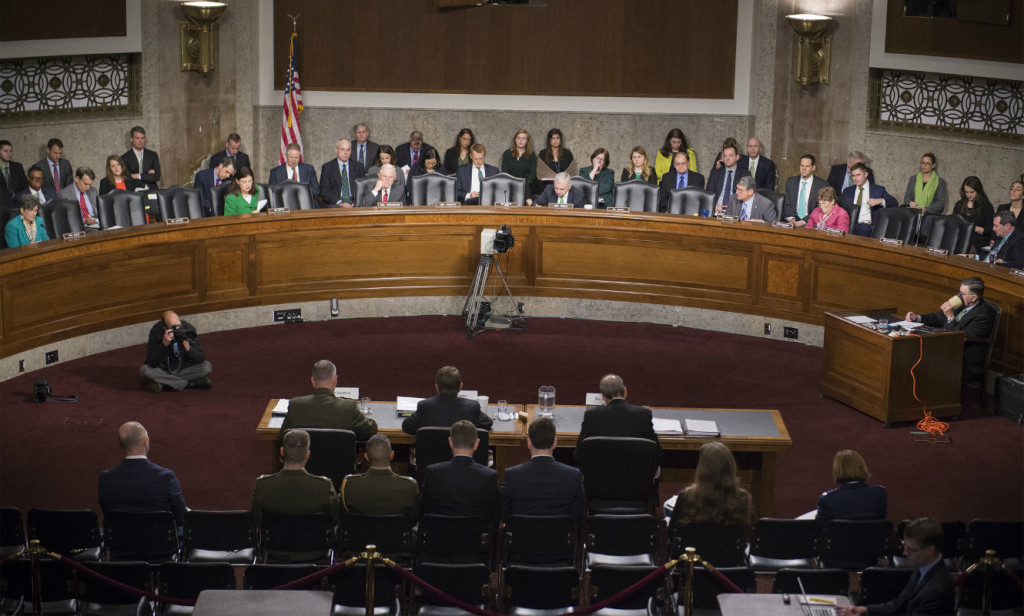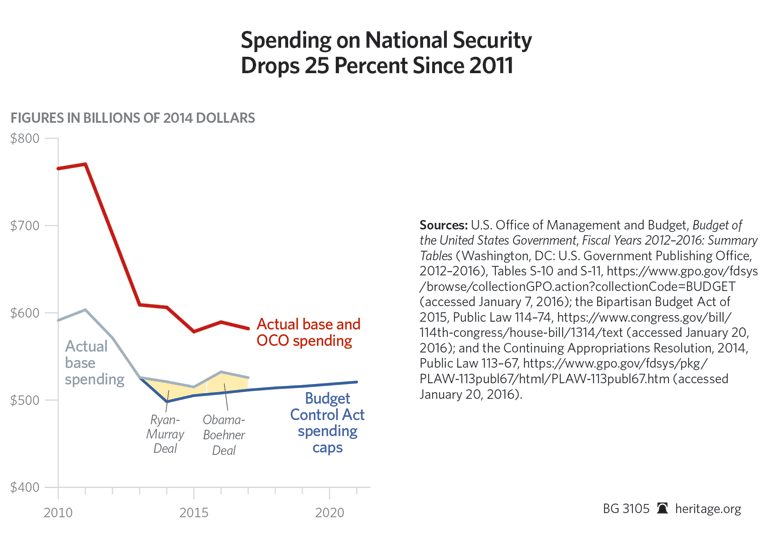

Congress will soon take up the National Defense Authorization Act (NDAA) for fiscal year 2017. The NDAA is an annual bill that sets policies and budgets for the U.S. Department of Defense. This bill and the defense appropriations bill are Congress’s two annual major pieces of defense legislation.
The Status of the U.S. Military
Years of budget cuts have resulted in a smaller and weaker military. The Heritage Foundation’s 2016 Index of U.S. Military Strength graded the U.S. military’s capability, capacity, and readiness and found that as a whole it is only “marginal.” In fact, both the Army and the Air Force dropped in their ratings from the previous year due to capacity and readiness cuts. In short, our military today is not able to adequately provide for America’s national security needs.
Unfortunately, rebuilding America’s military strength is not as simple as increasing the budget for a year or two. Rebuilding a unit, buying new equipment, or increasing a unit’s readiness can take years. At the same time, America faces growing diplomatic and security challenges. There is a gap between what America needs to do and what it is capable of doing. That’s why Heritage experts have proposed a “gap strategy,” which focuses on three things: making America the engine of global economic freedom, strengthening enduring alliances, and beginning to rebuild the military. In the NDAA, Congress can work on the last two — rebuilding defense and strengthening alliances — but rebuilding defense must be the top priority.
Beginning to Rebuild America’s Military
The first overarching priority for the NDAA should be rebuilding America’s military power. As Congress develops the NDAA, six principles should guide its members’ work:
1. Restore capacity, particularly of U.S. ground forces. Cutting military capacity, such as the number of ships, planes, or soldiers, is often attractive as it can quickly produce significant savings. Pursuing immediate savings, however, comes at significant long-term expense: Rebuilding military capacity will take longer and cost even more. Even more importantly, the U.S. military is already too small and further capacity cuts will severely impact its ability to conduct missions around the globe. Senior military leaders like the Chief of Naval Operations and the Secretary of the Army nominee believe that growing threats require a larger force.
2. Prioritize readiness for all the services. Readiness — a measure of how prepared a military unit is for combat — is achieved by pilots flying necessary hours, ground forces conducting necessary training, and sailors and their ships steaming a sufficient number of days in support of fleet exercises. In tight budgets, the military’s readiness often suffers, as training and maintenance can be cut more easily than personnel or long-term contracts. Lower readiness levels means that either the United States has fewer planes, ships, and soldiers to send on a mission, or service members are sent into danger without the proper equipment and training. Congress should increase defense spending with explicit guidance that an increased amount should be directed to improving readiness.
3. Shift initiatives from the Overseas Contingency Operations (OCO) account to the baseline defense budget. The OCO account has been increasingly used, by both the Pentagon and Congress, as a means of circumventing budget cuts and spending caps imposed on national defense. While the desire to increase defense spending is a good one, it should be done through the normal defense budget, not through OCO. The OCO account (and its predecessors) were established in response to specific new threats and are technically considered “emergency” spending to circumvent spending caps. The Department of Defense now submits an annual OCO request along with their base budget request. The defense budget should be increased to fully incorporate OCO needs without decreasing the underlying defense budget. As outlined elsewhere, the FY 2017 defense budget should be at least $600 billion plus the full costs of OCO.
4. Increase funding for updating nuclear weapons and missile defense systems. Growing ballistic missile threats and other nations’ nuclear weapon capabilities make S. nuclear weapons and missile defense capabilities essential. A modern, flexible and capable nuclear weapons posture is vital to keeping the United States safe, allies assured, and enemies deterred.
5. Provide stability for modernization programs. The United States must continue to invest in improving its current military capabilities and developing future capabilities. The military did not invest in modernization sufficiently during much of the past two decades, and significant modernization investments were also squandered due to mismanagement and misguided priorities. As a result, many old platforms, such as 50-year-old KC-135 tankers, 35-year-old Marine Corps amphibious assault vehicles, and the Navy’s entire fleet of ballistic missile submarines, are simultaneously approaching the end of their functional capacity. Funding stability and strong management and oversight are vital to achieving the necessary modernization.
6. Increase the national defense budget. While the NDAA is primarily a policy bill, it also establishes budgets. From FY 2011 to FY 2015, total national security spending (budget function 050, including overseas operations) dropped by 24.9 percent in real terms. While that period included dramatic force reductions in Iraq and Afghanistan, recent events around the world and the operating tempo of the U.S. military show that this dramatic cut was misguided. Under the Bipartisan Budget Act of 2015 (BBA), defense spending increased slightly for FY 2016; thus, the FY 2011–FY 2016 change is now only a 23.5-percent real cut. Unfortunately, the BBA cap reduces inflation-adjusted defense spending in FY 2017, so the gap from FY 2011 grows back to 24.5 percent in real terms. The defense budget under the BBA is not sufficient to support the military that this nation needs. For FY 2017, the national defense budget (function 050) is now capped at $551 billion, plus $59 billion in Overseas Contingency Operations (OCO) funding. Instead, Congress should increase the base defense budget to at least $600 billion in FY 2017 with the full cost of overseas operations added on top.
 Of course, there are all kinds of defense issues addressed in the NDAA beyond these six principles. In a recent paper for the Heritage Foundation, my colleagues and I started with these six principles and developed a series of specific policy steps that should be taken in the NDAA, such as not prematurely retiring aircraft or ships, improving the military healthcare system, retaining common sense restrictions on transfers of Guantanamo Bay detainees, and cutting non-defense research funding that is often stuck into defense bills.
Of course, there are all kinds of defense issues addressed in the NDAA beyond these six principles. In a recent paper for the Heritage Foundation, my colleagues and I started with these six principles and developed a series of specific policy steps that should be taken in the NDAA, such as not prematurely retiring aircraft or ships, improving the military healthcare system, retaining common sense restrictions on transfers of Guantanamo Bay detainees, and cutting non-defense research funding that is often stuck into defense bills.
In the NDAA, Congress can also take serious steps to strengthen America’s alliances. The paper outlines a range of steps aimed specifically at America’s relationships with countries in Europe, the Middle East, and Asia, such as returning to the 2012 force structure levels in Europe and supporting the South China Sea Initiative created by last year’s NDAA.
The defense authorization bill regularly carries hundreds of provisions and sometimes cracks a thousand pages in length, so a single paper can’t address every possible topic. As in every year, the NDAA this year will include debates about a range of policy and programmatic topics and probably some that defense experts won’t expect (such as last year’s sage grouse debate). But members of Congress should keep two simple goals in mind for the NDAA: begin rebuilding America’s military, and strengthen America’s alliances.
Justin T. Johnson is the senior analyst for defense budgeting policy in The Heritage Foundation’s Center for National Defense.
Photo credit: Petty Officer 2nd Class Dominique A. Pineiro, U.S. Navy
